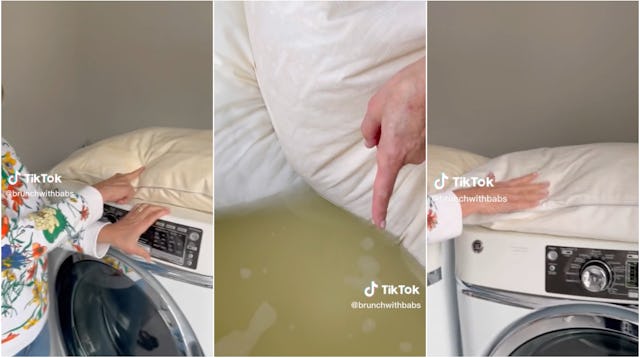This Grossly Satisfying Tutorial On Strip Washing Pillows Will Have You *Running* To Wash Yours
The internet’s favorite grandma comes through again.

If your mind was blown when you found out how often you should wash your linens, you’ll lose your sh*t over this news: You should be washing your pillows, too. Actually, according to the Asthma and Allergy Foundation, you should completely replace your pillows every two years. Meanwhile, some manufacturers suggest you do it every year. Can you imagine the cost?! Ain’t nobody got the time (or money) for that. And yet, have you ever changed your bed sheets in the sunlight? Those dingy yellow stains on your pillows come from sweat, drool, and body oils. Sure, it’s just your DNA. But you still try to wash it out of your clothes when you do laundry, so why not try to get it out of your pillows, too?
A simple wash will do in a pinch. However, everyone’s favorite TikToking grandma, Barbara “Babs” Costello (@BrunchWithBabs), suggests a semi-regular pillow “stripping” method. Just be forewarned — if you’ve never washed your pillows before, it’s gonna get really, really gross before it gets better.
"Experts say you're supposed to replace your pillows every 12 months. That would cost a fortune!" According to Costello, there's a way to get more life out of those stained pillows. "I'm going to strip my pillows instead,” she says. “First, fill up the tub with the hottest water possible. Next, add a quarter cup of baking soda and a quarter cup of Borax. Next up is two cups of liquid laundry detergent. And now stir. Time for the pillow bath. Just place it in the water and submerge it with a wooden spoon."
Babs suggests leaving your pillows to soak and detoxify for 24 hours. When you return, prepare to be shocked and disgusted by the color of the water. Even Babs, who seems to do everything right and keeps an astonishingly clean home, returned to greenish water in her tub. *barf*
The pillow stripping process isn't done yet, though. "Squeeze out the excess water in the pillows," instructs Babs. "Now into the washing machine on the normal cycle, no detergent." After you've washed them in the machine, too, Babs says to toss your pillows in the dryer but gives one crucial instruction: no dryer sheets! Use dryer balls or (new, clean) tennis balls to help fluff those pillows.
Babs’ Pillow-Stripping “Recipe” — Slightly Amended!
Although Babs is brilliant, many fans noted in the comments that using two full cups of laundry detergent feels excessive. According to Real Simple, you really only need 1/2 cup to properly strip wash your pillows. So, here’s what the recipe looks like slightly tweaked so that you aren’t watching money literally go down the drain:
- 1/4 cup baking soda or washing soda (sodium carbonate)
- 1/4 cup Borax
- 1/2 cup liquid laundry detergent
Mix into a tub of hot water and submerge your pillows. Babs recommends letting them soak for a full 24 hours, but you should be good to go if you can let them soak for at least four hours.
More Tips for Keeping Your Pillows Clean
- Use pillow covers. Just like mattresses, you can buy zip-on pillow covers in various fabrics that will help keep all your body oils from ever touching your pillow.
- Never sleep without a pillowcase. Pillowcases aren’t the end-all-be-all for keeping your pillows in good shape. They are, however, the first line of defense. Plus, it’s just better for your own skin and scalp to have an easily changed pillow cover.
- Wash your pillows regularly. You don’t need to strip your pillows every time. A regular wash on the gentle cycle in cold or warm water will do the trick. Go light on the detergent or skip it altogether. On warm, sunny days, consider giving your pillows some time to air-dry and let the sun work its magic on them. Tossing them into the dryer to pull out the final bits of moisture (and fluff ‘em up with some tennis balls) will help pillows stay looking and smelling fresh.
One final note from Babs? “Remember to always check the labels on those pillows. Memory foam and down pillows might not be recommended [for washing].”
This article was originally published on